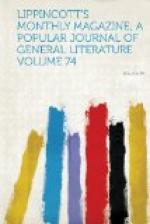barley and grass. This part of Cheshire has hardly
more diversity in its river-scenery, but the mere
presence of trees and green arbors makes it a pleasant
picture, while here and there, as at Overton (this
is Welsh, however, and belongs to Flintshire), a church-tower
comes in to complete the scene. Here the Dee
winds about a good deal, and receives its beautiful,
dashing tributary, the Alyn, which runs through the
Vale of Gresford and waters the park of Trevallyn Old
Hall, one of the loveliest of old English homes.
Its pointed gables and great clustering stacks of
chimneys, its mullioned and diamond-paned windows,
its finely-wooded park, all realize the stranger’s
ideal of the antique manor-house. This neighborhood
is studded with country-houses in all styles of architecture,
from the characteristic national to the uncomfortable
and cold foreign type. Houses that were meant
to stand in ilex-groves under a purple sky and a sun
of bronze look forlorn and uninviting under the gray
sky of England and amid its trees leafless for so many
months in the year: home associations seem impossible
in a porticoed house suggestive of outdoor living
and the relegation of chambers to the use of a mere
refuge from the weather. For many of these places
are no more than villas enlarged, and might be set
down with advantage to themselves in the Regent’s
Park in London, the very acme of the commonplace.
On the other hand, all the traditional associations
that go with an English hall presuppose a national
style of architecture. Even florid Tudor, even
sturdy “Queen Anne,” can stand juxtaposition
with groups of horses, dogs and huntsmen; Christmas
cheer and Christmas weather set them off all the better;
leafless trees are no drawback; the house looks warmer,
coseyer, more home-like, the worse the blast and rush
without. A roaring fire is natural to the huge
hall fireplace, while in a mosaic-paved “ante-room”
or a frescoed “saloon” it looks foreign
and out of place. Many an odd Welsh and English
house has unfortunately disappeared to make room for
a cold, unsuccessful monstrosity that reminds one
of a mammoth railway-station or a new hotel; and when
Welsh names are tacked on to these absurd dwellings
the contrast is as painful as it is forcible.
Such, for instance, is Bryn-y-Pys, on the Dee—a
house you might guess to belong to a Liverpool merchant
who had trusted to a common builder for a comfortable
home. Overton Cottage, on the other side, fills
in with its walks and plantations an abrupt bend of
the river, and the view from the up-going road at its
back is very lovely, though the scene is purely pastoral.
Overton Churchyard is one of the “seven wonders”
of North Wales: it has a very trim and stately
appearance, not that ragged, free if melancholy, outspreadedness
which distinguishes many country cemeteries, that
unpremeditated luxuriance of creepers and flowers,
blossoming bushes and grasses, that make up at least
half of one’s pleasant reminiscences of such




